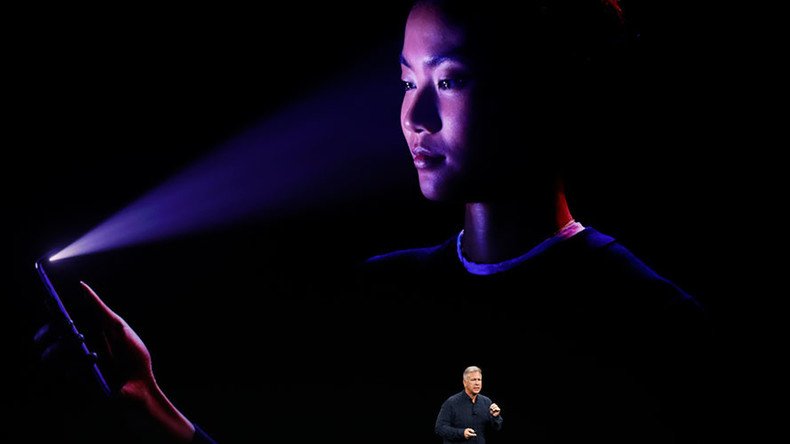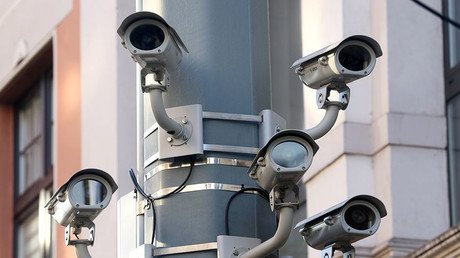Apple unveils new iPhone, Face ID feature fails in demo (VIDEO)

After detailing all the new bells and whistles that come with their newest iPhone, an Apple executive’s attempt to demonstrate the device’s facial recognition system failed several times.
In a keynote speech at the Steve Jobs Theater Tuesday, Phil Schiller, Apple’s senior vice president of worldwide marketing, unveiled the company’s new line of products, including the iPhone8, Apple Watch, Apple TV and AirPower, a wireless charging station for their products.
However, it was the iPhoneX that stole the show. For the first time, the company unveiled their ultra-premium iPhone to celebrate their tenth anniversary. The iPhoneX replaces the iconic “home” button, featured on all previous versions, with a new “TrueDepth camera system.” A little black bar at the top of the phone contains several sensors, cameras, and even a dot projector that all work together to create a mathematical 3D model of the owner’s face.
“With the iPhone X, your iPhone is locked until you look at it and it recognizes you. Nothing has ever been more simple, natural and effortless," Schiller said in his keynote speech. "This is the future of how we'll unlock our smartphones and protect our sensitive information.”
TrueDepth camera system #AppleEventpic.twitter.com/39Sk4dZqCg
— One Mapúa (@OneMapua) September 12, 2017
After extolling the benefits of Face ID in-depth, Craig Federighi, Apple’s software chief, came on stage to demonstrate just how easy it is to use the new feature.
“Unlocking it is as easy as looking at it and swiping up,” Federighi said.
After Federighi failed several attempts to unlock the iPhone by looking at it, the passcode screen popped up.
Seeing the Face ID fail at launch and the price of $999. NO!! pic.twitter.com/6uo7WB5Trk
— Akshat Tulsiyan (@rocking_akshat) September 12, 2017
“Ho, ho, ho,” Federighi said as he wiped sweat from his face. “Let’s go to back up here.”
Once Federighi picked up a second phone, the feature worked on the first try.
Many were quick to point out that the feature may not have failed, citing the lock screen on the phone that read: “Your passcode is required to enable Face ID.” Twitter users noted that a similar message pops up on existing iPhones when the user has not enabled the touch ID to recognize their fingerprints. Existing phones also require the user enter their passcode after the phone has been restarted or died as a security measure.
So the Face ID demo didn't actually fail on the first time. If you look closely, it was asking for the passcode to enable Face ID.
— Pedro Peguero Jr. (@pedropeguerojr) September 12, 2017
You can clearly see on it "you must type your passcode to enable face recognition" lmao it's the same as Touch ID
— Jay (@cribabyjay) September 12, 2017
Your passcode is required to enable face id on the top pic.twitter.com/yMe3iGorxO
— Nikhil Arthan (@NikhilArthan) September 12, 2017
However, many expressed doubts about the new feature, which they fear could allow others to gain access to their phones simply by pointing it at their face.
#FaceID
— Edward Snowden (@Snowden) September 12, 2017
Good: Design looks surprisingly robust, already has a panic disable.
Bad: Normalizes facial scanning, a tech certain to be abused.
With FaceID, cops can just point your phone at your face while they have you in handcuffs then look through your phone without a warrant.
— Jerrah Mormont (@BostonJerry) September 12, 2017
I like Apple's FaceID, but the official tagline, "Now anybody can unlock your phone while you sleep!" is a little nefarious sounding...
— Amir Blumenfeld (@jakeandamir) September 12, 2017
face id knows when you're looking at your phone. seems like an easy way to enable mandatory ad viewing. no thanks.
— pronoun enforcer (@ohsnapyoo) September 12, 2017
Apple explains that the feature will only work when the user looks at the device with their eyes open.
#Apple responded with customer data in 78 percent of all US gov't requests made from July to December 2016. https://t.co/g2WYH4cCne
— RT America (@RT_America) May 23, 2017
Schiller also explained that the Face ID actually offers more security than the Touch ID, which was featured on previous versions of the iPhone and used the owner’s fingerprints to unlock the device. According to Schiller, the Touch ID had a false unlock rate of one in 50,000, whereas the new Face ID only had an error rate of one in 1 million.
He added that Face ID will recognize a user even when they change their hairstyle, put on glasses, wear a hat or change their appearance in other ways.
The Apple New iPhone X #AppleEventpic.twitter.com/szw272jPYG
— 9GAG (@9GAG) September 12, 2017
This man is going to break FaceID #AppleEventpic.twitter.com/Rkp07cgVlo
— Luisa Haynes (@wokeluisa) September 12, 2017













